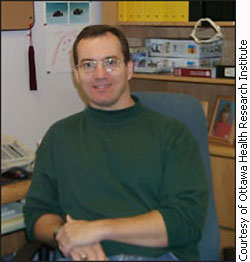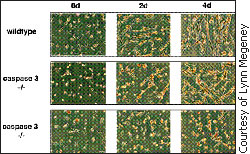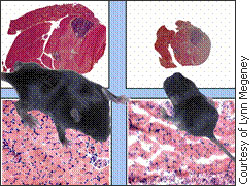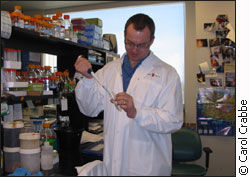
|
| Muscles withering away can be plumped right back. Cancer causing cells can be effectively destroyed with minimum invasion, and the right drugs are prescribed for diseases every time – a perfect world. Utopia is still some time away, but with some basic digging into stem cells and what controls them, researchers in Ottawa are making progress in improving the quality of life as we know it.
Stem cells are the building blocks of life. They are the blank cells from which specialized cells develop for the body to use. What this means is that a stem cell can become a red blood cell, a heart muscle cell or even a skin cell. These cells impact human life in many ways. In a presentation at the 2006 annual meeting of the American Association for the Advancement of Science, professor Jonathan Garlick of Tufts University said one of the ways stem cells are used naturally is to heal wounds in the skin. This happens he said, by the migration of the stem cells to fill up the gaps left by the wound. Stem cells then, are not just the building blocks of life, but are also important for repairing and maintaining it. The essential nature of stem cells interests scientists because there is a vast amount of information that can be garnered from them. Researching stem cells Researchers all over the world are studying different aspects of stem cells. However, this area of research is fraught with controversy and there are lobby groups and huge amounts of literature dedicated to each side of the argument.
Lynn Megeney of the Ottawa Health Research Institute is one of the researchers who have faced resistance to their work. Megeney is also part of Canada's Stem Cell Network, and for the past six years, he has been finding out how proteins control differentiation in stem cells. To understand why there is opposition to Megeney's work, you have to understand his research. The basic premise of Megeney's work is that the same proteins control the two very different processes of differentiation and apoptosis in cells. Differentiation is the process by which a cell divides and acquires certain characteristics to become a specialized cell. The process can be likened to cooking an egg, where the first step is cracking open the egg, second is adding salt and pepper and third is frying the egg. In this case, the whole egg would be the stem cell, cracking it open would correspond with the cell dividing, the salt would be one of the special features the cell could develop and finally, frying the egg would relate to the lining up of the unique cells to form tissues and other such structures.
Just as when cooking an egg, the spices and other ingredients added determine the final product, with cells, the special features they develop determine what kind of specialized cell the stem cell becomes. So for example, an egg becomes a three cheese omelette if three cheeses are added and a stem cell becomes a nerve cell then nerve tissue if it develops dendrites and other features unique to nerve cells. This process of differentiation is controlled by proteins, a well documented fact. However, it is not clear exactly why these proteins act the way they do, and this is precisely what Megeney is interested in. Cell suicide "There were gaps in the research," Megeney says, and there were things the proteins could not explain. One of these gaps was why apoptosis, or programmed cell death occurred. This process, also known as "cell suicide" is when a cell kills itself off. In humans, it usually occurs when the body wants to get rid of unneeded cells. With some seemingly basic experiments using skeletal muscle cells, Megeney says he came up with some surprising results. According to him, caspases are the main proteins known to control "cell suicide".
In his experiment, he used caspase-3 on muscle cells from mice and found that the protein not only controlled how the cells killed themselves off, but also controlled how they divided and became specialized cells. He says he found that when the cells were dividing and becoming more specialized, the amount of the proteins which were previously thought to control "cell suicide," were increasing in the cells. To test this further, he removed the protein – caspase-3 – from the muscle cells of the mice and says he found that the mice became unhealthy and did not survive for much longer after that. Opposition to the findings Megeney says this is hard evidence that the apoptotic pathways – that is how the proteins got into the cells – also enhanced differentiation of the cells so that the mice could grow. But not everyone thinks so. Megeney published his findings in 2002 after much opposition. He recalls that one of the reviewers was adamant that this finding was unreal.
"It could not be happening," Megeney quotes the reviewer. There was "so much animosity to this concept," he adds, when he first began. The opposition came mostly because Megeney and his team were challenging a well established concept in science. This concept was that proteins like caspases regulate "cell suicide". What Megeney was proposing was that these proteins actually controlled differentiation and when the protein levels became too high, the cells killed themselves off. Support for the research "It's like too much of a good thing," Megeney says. When the proteins are present, the blank stem cells are able to effectively differentiate and as a result, the organism develops. But when the protein levels are too high, they cause the cells to kill themselves off. In his support, Megeney says other scientists interested in his area of research have confirmed his findings. He says in the United States of America and Japan for example, other scientists have reached the same conclusions. While Megeney used skeletal muscle cells, he says these other researchers used cells from the bone, blood, skin and eye.
In other countries, scientists have used muscle and nerve cells with the same findings. Megeney calls the widespread nature of the research a "universal phenomenon," and he says he is confident that in the coming years, the concept of apoptosis – programmed cell death – will be redefined. Opponents of Megeney's theories argue that cells have to die for the organism to develop and therefore the proteins are primarily for "cell suicide" and not for the "life-giving process" of differentiation. However, Megeney says that even if the concept is approached from an evolutionary point of view, it is possible to argue that the pathways the proteins used to kill off the cells the body did not need, evolved to become more useful for the cells by also enhancing differentiation. If not, "there would be a lot of pressure on the cell to change this system to help the cell survive [instead of dying off]," he says. Life-giving possibilities There are important implications of this particular research which has been done in human, mouse and fruit-fly cells for drug research, cancer research and other research into degenerative human diseases. Megeney says in some cancers for example, the stem cells are not able to differentiate. If the proteins can be controlled then, the cells can be manipulated so they become a useful cell. The step of healing human disease is far off though. For now, Megeney is working on defining the basic concepts and finding out how the processes work by looking at the proteins which control them. With this basis, further research can be done which will lead to larger strides in treating human diseases.
|
|
|



